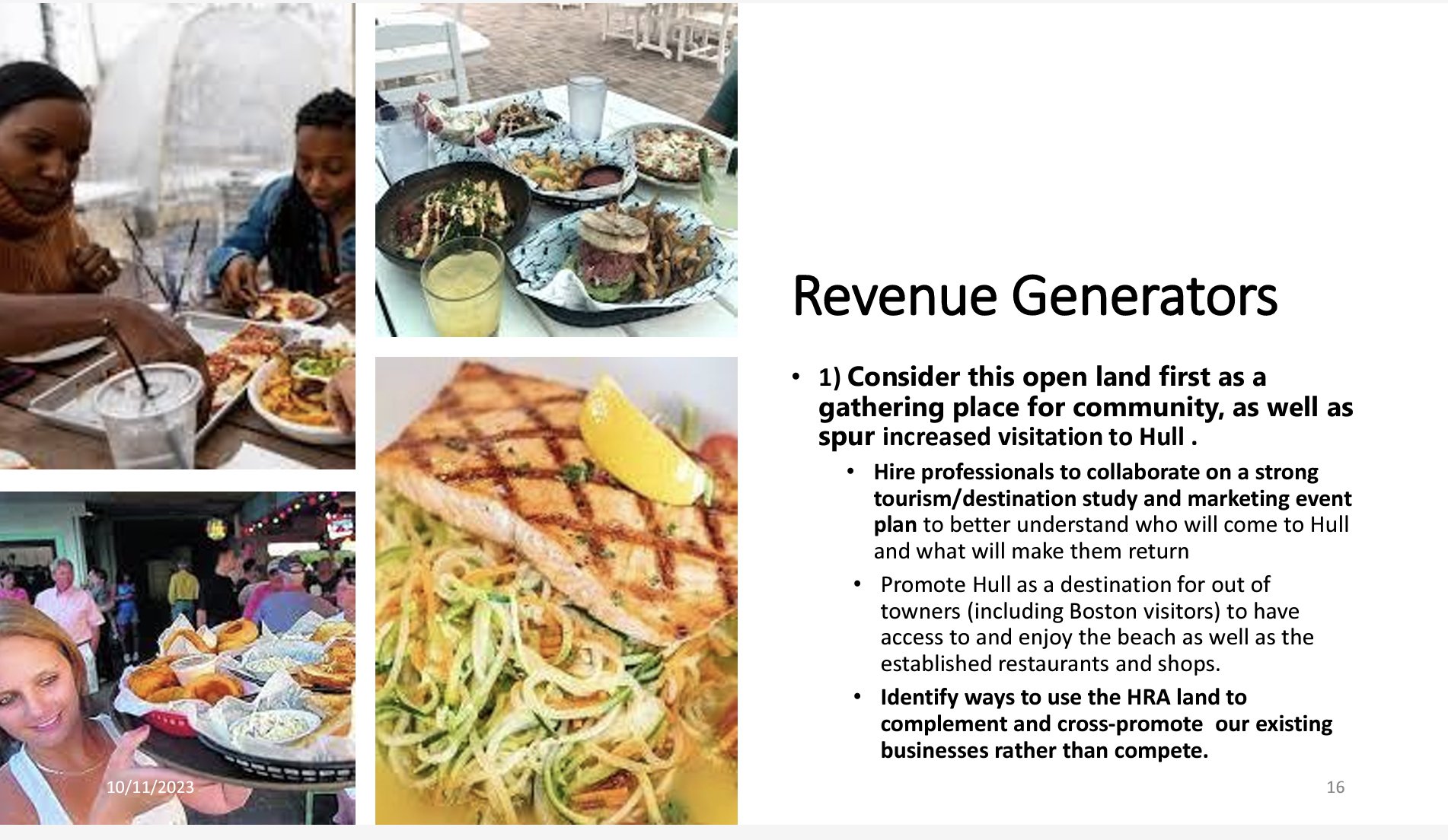Public-private partnerships could fund event venue, concessions on HRA land
/By Dolores Sauca Lorusso
At last week’s meeting of the Hull Redevelopment Authority, representatives of the SOS Hull organization answered follow-up questions about their proposal for uses for the HRA land.
Questions were presented to SOS Hull’s Liz Kay and Susan Vermilya by HRA Chair Dennis Zaia, who focused on the broader scope of the presentation, while HRA Clerk Adrienne Paquin dug into the details.
Zaia asked Kay and Vermilya what they would suggest as first steps for the HRA to initiate a collaborative relationship with the Department of Conservation and Recreation (DCR).
“As a strategic planner, my approach is to be sure we are gathering all the information together as one and reach out to DCR to understand their short- and long-term visions and intentions,” said Kay.
Kay said the town is working with the DCR on a memorandum of understanding to outline how the two parties will work together.
CLICK HERE FOR THE FULL PRESENTATION
“If I was the HRA, as a stakeholder, I would like to understand what that is and the goal and objective of the document… every time we sort of divide and conquer by neighborhood, I feel like we are deflating the importance of maintaining the relationship with the DCR, but also how holistically we treat our land and our development,” she said.
Zaia said he already reached out to Town Manager Jennifer Constable about the HRA being involved in the agreement with the DCR.
“I reached out asking them to include us in some way, shape, or form, because we are part of the solution,” he said.
He said it is a “great beginning because I think we all know the DCR and the town have not always played well together in the world of communication… the new town manager and new [DCR] commissioner have a willingness to set the table together. I think we will see some positivity there.”
SOS Hull also suggested that the town and DCR hire a consultant to facilitate dialogue between key stakeholders to develop a “cohesive vision for Hull.”
Zaia also asked the SOS representatives how the examples in their presentation – Boston’s Rose Kennedy Greenway, Christopher Columbus Park, and Faneuil Hall Marketplace – can generate “financial stability in the absence of capital from another entity.”
Kay said that private dollars from New England Aquarium founder David B. Stone and Boston Harbor Hotel developer Norman Leventhal “jumpstarted” Boston’s redevelopment initiatives along the waterfront in previous decades.
“Between those private dollars and not-for-profit entities, and funding from travel and tourism and historic preservation, and others, they started to build a constituency of organizations that were seeking to develop Boston Harbor’s waterfront,” Kay said. “They are city people identifying ways to take their dollars in for tax revenues and benefits for their companies, and investing dollars in initiatives to build new enterprises for cities and communities.”
Kay also referred to the Marginal Way in Ogunquit, Maine, where a non-profit stepped in to fund management and care of a waterfront property after the Army Corps of Engineers pulled back.
“It has spearheaded a not-for-profit organization to fund the management and upkeep and care of that property to keep it open to the public,” she said. “The principles all play the same way, they just have to be right-sized.”
Zaia said many proposals the HRA has received suggested making all the “amenities happen,” and he “struggles” with that fact.
“[There] needs to be some dollar investment to move this kind of initiative to make the property more valuable, sustainable, and better,” he said.
Kay said the HRA has funds in its bank account.
“I don’t know legally if you could crate a not-for-profit arm of the HRA,” she said. “[I am] making it up as I go here.”
“It is OK, we are all making it up,” said Zaia, who expressed his thanks for the “clarity” Kay shed upon some areas where he was “stuck,” and now he can see there are “bridges from both sides.”
Paquin focused on the details of the plan, and asked how SOS Hull sees the main festival area and overflow parking aspects of its proposal. She wanted to know how the group would “not leave us with what we have now – a kind of dirty field that is mixed-used space for parking, but then sometimes for concerts; is that what you are envisioning?”
Vermilya said SOS Hull is not looking for the property to look like it does today.
“We would like to get a landscape architect that s experienced in the coastal communities and knows about resiliency, what will work on that land, as well as what will protect the land,” said Vermilya.
She added that in recent storms, water pooled on the property, and “as part of whatever happens on that land, we would be looking at how we mitigate the ocean coming over and swamping the area.”
Vermilya said the parcel closest to the DCR parking lot is where her group envisions an event venue area that could be made of semipermeable pavers. The pavers also would allow the mobile stage to move more easily and be used for parking when needed. They would also like to complement the parking with a bus depot.
Paquin asked about the vision for seasonal concessions. Vermilya said she thinks “we are leaving money on the table by not putting some sort of concession in that area…so many people come to the beach, park, and leave.”
Vermilya noted the town could benefit from tax revenues from those concessions if structured correctly. She envisions the HRA, or another governing body, would issue a request for proposals every year, and priority would be given to existing town businesses.
Kay said she is excited that the town manager is seeking to bring together some kind of business group in Hull to help “reinvigorate activity.”
“Research needs to be done on what is most viable there for those businesses, be well promoted to the community, and have a collective vision on how to support those restaurants and businesses,” she said.
SOS Hull also believes there needs to be a change in behavior over time regarding traffic and parking.
“The reality is they could access the MBTA and be coming in on buses…park in the DCR lot and take pedicabs over to the beach [to] introduce them to the community,” said Kay.
Paquin also asked about SOS Hull’s ideas on potential funding sources for parking.
Vermilya mentioned funding through the state’s Shared Streets and Spaces Grant Program and the Department of Housing and Community Development’s Massachusetts Downtown Initiative.
Town Planner Chris DiIorio said the town is always looking at public-private partnerships. For example, the Shared Streets and Spaces Grant Program was used to improve pedestrian flow near the Mezzo Mare restaurant property, which is owned by the town.
On Monday, February 12, DiIorio, the town manager, and a consultant will meet with the HRA about a proposed Business Improvement District.
“Your presentation has given me more robust information on what I am going to pitch to the members of the authority on Monday March 4…this is the date we have set to do our talks to each other,” said Zaia.
Like what you’re reading? Stay informed with a Hull Times subscription by clicking here.
Do you have an opinion on this issue? Click here to write a Letter to the Editor.













